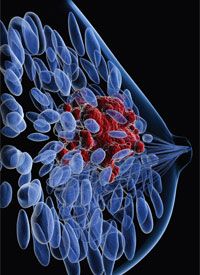Adjuvant Trastuzumab Emtansine Approved in UK for HER2+ Early Breast Cancer
Trastuzumab emtansine has been approved in the UK for the adjuvant treatment of patients with HER2-positive early breast cancer.
breast cancer

The United Kingdom’s National Institute for Health and Care Excellence (NICE) has recommended trastuzumab emtansine (T-DM1; Kadcyla) for the adjuvant treatment of patients with HER2-positive early breast cancer who have residual invasive disease in the breast or lymph nodes after neoadjuvant taxane-based and HER2-targeted therapy.1
The recommendation was based on findings from the phase 3 KATHERINE study, in which T-DM1 reduced the risk of invasive disease recurrence or death by 50% compared with trastuzumab (Herceptin) in this setting (HR, 0.50; 95% CI, 0.39-0.64; P <.0001). The 3-year invasive disease-free survival (iDFS) rate was 88.3% with T-DM1 versus 77.0% with trastuzumab, leading to an absolute improvement of 11.3%.
The iDFS benefit with T-DM1 was upheld across key patient subgroups, according to results presented at the 2018 San Antonio Breast Cancer Symposium and simultaneously published in the New England Journal of Medicine.2,3
The treatment will now be available in the UK for this indication through the National Health Service (NHS). According to NICE, on average, T-DM1 costs £51,000 per patient at its full list price for a treatment course. Roche, the developer of T-DM1 has entered into a commercial agreement with the NHS to make the drug available at an undisclosed discount.
“Additional treatment options that can increase the amount of time in which people remain free of disease after surgery, and perhaps stop it from coming back altogether, are particularly welcome. We are therefore pleased to be able to recommend that trastuzumab emtansine is made available routinely for people with HER2-positive early breast cancer after surgery,” Meindert Boysen, deputy chief executive and director of the Centre for Health Technology Evaluation at NICE, said in a press release.
The open-label KATHERINE trial included 1486 patients with centrally confirmed HER2-positive, nonmetastatic, invasive primary breast cancer who were found to have residual invasive tumor in the breast or axillary nodes at surgery after completing neoadjuvant chemotherapy. Neoadjuvant chemotherapy had to consist of ≥6 cycles of chemotherapy containing a taxane (with or without anthracycline) and ≥9 weeks of trastuzumab.
Patient characteristics were well balanced between the 2 study arms. Across the study population, the median age was 49, three-fourths of patients were white, and 75% of patients had operable breast cancer at presentation. Three-fourths of patients in both arms were ER-positive, PR-positive, or both.
Over seventy-six percent of patients had prior anthracycline use. Across both arms, neoadjuvant HER2-targeted therapy consisted of trastuzumab alone for approximately 80% of patients, trastuzumab plus pertuzumab (Perjeta) for 19%, and trastuzumab plus other HER2-targeted therapy (neratinib, dacomitinib, afatinib, and lapatinib) for 1%.
Patients were randomized within 12 weeks of surgery to either T-DM1 at 3.6 mg/kg IV (n = 743) or trastuzumab at 6 mg/kg IV (n = 743). Both agents were administered every 3 weeks for 14 cycles.
The consistent iDFS benefit with T-DM1 was shown across several key subgroups: operable disease at presentation (HR, 0.47), inoperable disease at presentation (HR, 0.54), negative hormone receptor status (HR, 0.50), positive hormone receptor status (HR, 0.48), trastuzumab as only anti-HER2 agent in neoadjuvant setting (HR, 0.49), trastuzumab plus ≥1 anti-HER2 agent in neoadjuvant setting (HR, 0.54), node-positive disease after neoadjuvant treatment (HR, 0.52), and node-negative disease after neoadjuvant treatment (HR, 0.44).
The safety analysis included 740 patients in the T-DM1 arm and 720 patients in the trastuzumab arm.
The rate of grade ≥3 adverse events (AEs) was 26% versus 15%, and the rate of serious AEs was 12.7% versus 8.1%, respectively. AE-related discontinuations occurred in 18% of the T-DM1 arm versus 2.1% in the trastuzumab arm.
The most common grade ≥3 AEs across the overall population included thrombocytopenia (6% with T-DM1 vs 0.3% with trastuzumab) and hypertension (2.0% vs 1.2%, respectively).
References
- NICE draft guidance recommends new treatment option for people with early breast cancer. Published May 7, 2020. https://bit.ly/3fvTv3N. Accessed May 7, 2020.
- Geyer Jr CE, Huang C-S, Mano MS, et al. Phase III Study of Trastuzumab Emtansine(T-DM1) vs Trastuzumab as Adjuvant Therapy in Patients with HER2-Positive Early Breast Cancer with Residual Invasive Disease after Neoadjuvant Chemotherapy and HER2-Targeted Therapy Including Trastuzumab: Primary Results from KATHERINE (NSABP B-50-I, GBG 77 and Roche BO27938). Presented at: 2018 San Antonio Breast Cancer Symposium; December 4-8, 2018; San Antonio, TX. Abstract GS1-10.
- von Minckwitz G, Huang C-S, Mano MS, et al. Trastuzumab emtansine for residual invasive HER2-positive breast cancer [published online December 5, 2018]. New Engl J Med. doi: 10.1056/NEJMoa1814017.



